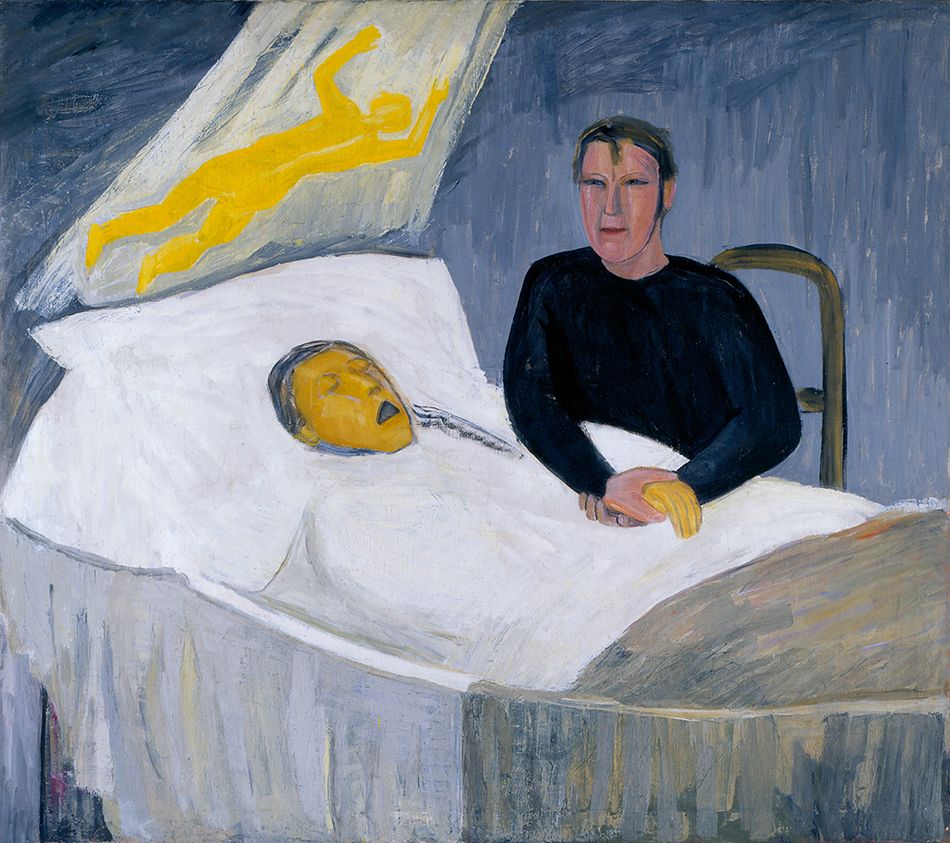Olivia Holm-Møller
Collection
Olivia Holm-Møller (1875-1970) is one of the greatest Danish painters of the 20th Century, who throughout her life had the courage to go her own way. She drew inspiration for her expressive and cosmic symbolic imagery from the Bible and Norse mythology and found her motifs in her immediate surroundings such as family pictures and domestic harvest scenes. In addition, her enthusiasm for traveling became increasingly more visible in her works. Olivia Holm-Møller also discovered her own version of abstract painting quite early in a Danish context.
As part of the presentation, the new acquisition Harvest Scene with Sun from 1933 can be seen. The painting is among Olivia Holm-Møller’s harvest paintings, which she worked on from the late 1920s to the late 1940s, but Harvest Scene with Sun is distinguished by its special light, foreboding atmosphere and the enigmatic, greenish sun with a halo that hovers in front of the horizon line like a mysterious celestial phenomenon. The painting shares this feature with Holm-Møller’s more abstract compositions of a cosmic nature from the mid-1930s onwards, which she called colour and rhythm paintings. In Harvest Scene with Sun Holm-Møller thus unites different artistic endeavors in one work.
The painting was donated by Krogerup Folk High School in 2024 and has been restored at the Art Conservation Center in Silkeborg - an extensive process that has provided insight into Olivia Holm-Møller's painting technique and use of home-made tempera. More information about both can be found in the presentation via texts and a display case. The exhibition also shows a portrait film about Olivia Holm-Møller from 1966, produced by visual artist and author Per Ulrich. You can also explore Olivia Holm-Møller's Letter Archive via a tablet.
Upbringing and artistic development
Olivia Holm-Møller was born in Homå, Djursland, to a home characterised by the so-called ‘free schools’, an alternative system to the state schools, and the educational thinking of the Danish priest and philosopher NFS Grundtvig and his ‘folk high schools’. She attended Emilie Mundt and Marie Luplau’s School of Drawing and the Royal Danish Academy of Fine Art in Copenhagen, and made her debut as an artist at the Charlottenborg Spring Exhibition in 1908. At the start of her artistic career, she worked mainly with sculpture and relief in a clear, classical manner, but she soon also began to work with etchings and woodcuts, in a simplified yet monumental style. From 1914 onward painting became her central medium of expression, created in a raw idiom with intense colours. Among her sources of inspiration were J.F. Willumsen and Ejnar Nielsen, both of whom she met. In the same year, 1914, Olivia Holm-Møller returned to Homå when her sister-in-law died in childbirth, and she assumed the role of foster mother to her two small nephews.
Foreign travel and the search for humanity
In the 1920s Holm-Møller rented a studio in Copenhagen, and in the same period she intensified her travel activities. In 1937 she exhibited her first purely abstract pictures, Kun farve og rytme (Only Colour and Rhythm). Thereafter, the unification of the figurative and the abstract was to characterise much of her production, which depicts the fundamental forces of life in a vehement visionary form.
After the war, she sold her house in Djursland and bought a summer house in Vejby Strand. Following her 70th birthday, she travelled to Algiers, Tunis and Morocco in North Africa in a continuing search for universal human values. She then visited Mexico to study pre-Columbian art and the Mexican painter José Clemente Orozco, and also made trips to the Middle East, Africa, India and the Himalayas. In 1956, at the age of 80, she bought a large villa in Rungsted and lived and painted there, at the same time journeying to Switzerland, Turkey, Greece, China and what was then Tanganyika in the area around Kilimanjaro. Olivia Holm-Møller painted her last picture in 1964, and died at home on the 3rd of November 1970, two days before her birthday, aged 94.
Career and artistic life
Olivia Holm-Møller had been politically conscious since attending folk high school. She was wayward in all aspects of her life, preferring to live in isolation, and was often at odds with the established art world. However, her extensive exhibition activities lasted her entire lifetime and testifies to a great artistic personality. Initially she cultivated joint exhibition communities with close colleagues, and later she participated in a number of group exhibitions. At Den Frie Centre of Contemporary Art alone, Olivia Holm-Møller held no less than 20 separate exhibitions. In 1904, while still a student at the Royal Danish Academy of Fine Art, she carried out her first decorative task as a sculptor: a relief for the chapel of Øster Kirkegård in Vejle.
The collection comes to Holstebro
After her death, a large collection of Olivia Holm-Møller’s own paintings and sculptures arrived at Museet Holmen in Løgumkloster in Southern Jutland. The collection was subsequently transferred to the Jens Nielsen Museum in Holstebro, which changed its name to the Jens Nielsen & Olivia Holm-Møller Museum in 1982. In 1987, the museum became a branch of Holstebro Kunstmuseum. The branch was dissolved at the end of 2013, but her many works remain part of the Holstebro Kunstmuseum collections today.
Artistic legacy
In retrospect, Olivia Holm-Møller’s art forms a link between the early Danish modernism of he 1910s and 1920s and the later COBRA school of painting from around 1950. She has recently gained a new following, and has been an inspiration to subsequent generations of artists, including Ursula Reuter Christiansen and Tal R.
In 1937 Olivia Holm-Møller exhibited her first purely abstract pictures, 'Kun farve og rytme' (Only Colour and Rhythm). Thereafter, the unification of the figurative and the abstract was to characterise much of her production, which depicts the fundamental forces of life in a vehement visionary form.



